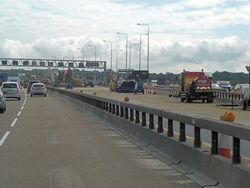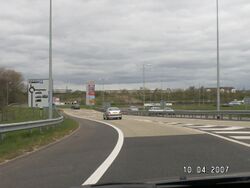National Highways

'National Highways' is the current name of the government-owned company responsible for operating, maintaining and improving most of England's motorways and trunk routes. The same name is used by a few organisations around the world, but this page only deals with the one in England. Despite that name, their role is devolved to regional assemblies in Scotland, Wales, Northern Ireland and London, who all use their own branding.
In terms of motorway service areas, National Highways are responsible for regulating the service areas on its network through an MSA Policy and signage guide and signage agreements, and to work with developers over issues such as access and signage. As part of their duty to ensure the safe operation of their road network, they also need to encourage motorists to use service areas when tired.
Predecessors
Motorway service areas were created by the "Highways Special Roads" division of the Ministry of Transport. They were in charge of planning new service areas, analysing proposals, acquiring the land, building the base, working with the developer, setting policies, inspecting the service areas, approving any changes and ensuring any issues were followed up.
This soon became too much work for the organisation who were also trying to build hundreds of miles of new motorway, so in 1969 they created the Motorway Service Area Branch (MSAB, sometimes called the MSA Board). They took on most of the above responsibilities and played a key role in the period where the industry was now finding its feet.
The MSAB survived the Ministry of Transport being renamed Department of the Environment, and again when it became the Department of Transport, but the Prior Report suggested the quango be wound up. This happened in 1982, when the responsibility for service areas was moved to the newly-created "Highways Lands and Services" division of the Department of Transport. The new division kept less of a close eye on matters, but was still the landlord and as such had to authorise all major changes.
The Department of Transport created the 'Highways Agency' in 1994. This new executive agency was responsible for England's motorways and trunk roads, and service stations fell under the new "Network General and Maintenance" division. They were no longer involved in developing new service areas, but would assess new proposals, create the regulations and ensure they were adhered to through traffic signs agreements, which in turn meant they were still in charge of any name changes.
The Highways Agency later started highlighting areas where new facilities were needed, a statement which could then be considered by local planning authorities when dealing with new proposals. They continued to meet yearly with the operators to address any operational concerns, but they had much less day-to-day involvement.
As recently as 2007, the Highways Agency still had a list of the service areas on their network (with errors), but evidently by 2010 that had gone missing, because their study into service area locations was based on data provided by this website. This has happened several times since.
The Highways Agency were converted to a company in 2015, at which point they became Highways England. Highways England had marginally less authority, for example, they cannot authorise new road signs for service areas. They changed their name again, this time to National Highways, in 2021.
Freeholds

The government re-negotiated the contract under which all of England's service areas operated in 1982. From now on the operator would purchase a 50 year lease, generally awarded to the highest bidder, and pay the landowner (the Department of Transport) a peppercorn rent.
These freeholds were passed to the Highways Agency. As part of the complete privatisation of the industry, they were instructed to sell all of them, in a process known as disposals. Some operators had been hoping to be handed the land as compensation for the contract change, but instead the land was sold to the highest bidder to encourage the operators to bid high. One government spokesperson said he wanted to see "pension funds, insurance companies and leisure groups" making bids, adding that they would see "long-term increases in site values".
By 1996, 29 of these had been sold. Political issues caused the process to be postponed indefinitely, and as a result National Highways still owns the freehold to the remaining 21 services:
- Birch (M62)
- Birchanger Green (M11)
- Cherwell Valley (M40)
- Clacket Lane (M25)
- Corley (M6)
- Keele (M6)
- Knutsford (M6)
- Leicester Forest East (M1)
- Membury (M4)
- Newport Pagnell (M1)
- Northampton (M1)
- Norton Canes (M6 Toll)
- Sandbach (M6)
- South Mimms (forecourt and truckstop only) (M25)
- Strensham (M5)
- Thurrock (M25)
- Toddington (M1)
- Trowell (M1)
- Warwick (M40)
- Watford Gap (M1)
- Woodall (M1)
This information was verified in January 2018. Since then some sources have disputed it. It is possible that some land has been sold or other agreements have been reached. The Welcome Break sites had their leases extended by 75 years in 2025, which National Highways suggested was to encourage investment in charging facilities.
Note that the inclusion of a service area on this list does not mean that National Highways own the whole site. Since 1992, service areas such as Northampton have expanded into land they purchased privately. The hotel at Newport Pagnell, despite being one of the oldest service station hotels, was not built on highway land.
In addition to the service areas listed above, National Highways also inherited land which had been reserved for future motorway service areas but never built. Tracking the current status of these is difficult. In 2015, National Highways were reported to own:
- Moreton Valence (M5)
- Kingston Seymour (M5)
Other sources report that National Highways owns:
- Chigwell (M11; whole site, even parts which aren't used)
- Doxey (M6; majority of the site is owned)
- Lutterworth (M1; whole site, mostly used)
- Newton-le-Willows (M6; the entire southbound side, even the land which isn't used)
- Sprotbrough (A1(M); whole site, mostly used)
- Trumps Green (M3; north-eastbound side only)
Picnic Areas
National Highways are responsible for providing safe lay-bys along the A-road network, some of which have an agreement with a trader to allow them to conduct business there.
Over the years there have been a number of experiments with larger lay-bys, many of which have toilets and refreshment facilities. Historically there has been confusion with how these should be treated, but it's now agreed that they should be classed as "picnic areas" and signposted as a tourist attraction.
For maintenance purposes, these picnic areas fall under National Highways's responsibility, and usually have their predecessor's logo attached to the wall. Some of the largest examples, which are documented on this website, are:
- Cartgate picnic area (A303)
- Sedbury lay-by (A66)
- Great Dunmow rest area (A120)
New regulations, announced in 2022, stated that National Highways can provide roadside facilities themselves, where necessary. In practice, this is likely to encourage the building of a few picnic areas like those above, rather than the construction of large service areas.
Work With Operators

As part of their responsibilities the Highways Agency created and manage the MSA Policy for England on behalf of the Department for Transport, and as such they should highlight roads that could benefit from new service area construction. National Highways have to be consulted on all major changes at service areas in England. They have begun speaking in favour of proposed new service area developments.
Officially, National Highways are responsible for regulating the behaviour and layout of motorway service areas on their network. However, the 2013 version of the policy became very light on rules or policies. The government attitude at the time was effectively that all commercial development is good, and as a result National Highways wrote themselves into a position where they were only really able to speak out if they believe a proposal is actively dangerous (as opposed to it merely being badly thought out). This was partly because National Highways are only a government-owned company, and not an actual executive agency, meaning their remit is more limited; their roadside facilities department became a tiny and much-forgotten unit.
Although National Highways are very strict about who is allowed to work on their motorways, approved contractors can make changes to road signs on behalf of an operator provided National Highways are informed. This allowed operators to frequently change their headerboards without inconveniencing the highway authority.
Whenever there is a problem with fuel, charging or the amenity building at an English motorway service area, they should inform National Highways so the pre-programmed motorway warning signs can be activated. Some sites can Scotland and Wales can ask for warnings to be placed in England, too.
Operators are required to support National Highways and the Department for Transport with any campaigns they may be running. Traditionally this was provided with posters and space for stands; these days it tends to mean sharing social media campaigns and news releases.
Past Projects
The Highways Agency had previously worked with the operators to provide interactive traffic information. Briefly, they published a guide to truckstop cafés in England, which included details of a small number of motorway service areas.
In April 2020, Highways England launched a new spreadsheet which promised to provide live information on motorway service area facilities. Despite receiving widespread praise in the media for doing this, the spreadsheet was only updated once every 24 hours, and missed almost every single motorway service area closure that happened, including scheduled closures that their colleagues had posted about on Highways England's social media pages. The service was quietly removed after a few months, and Highways England instead referred people to this website for updates.
Their next publicity project related to service stations was in August 2021, when they worked with AccessAble on an actually important and useful facilities guide, though it wasn't kept up-to-date.
Highways England allocated land for a motorway service area on the planned A122 Lower Thames Crossing in 2018. They weren't planning to create the service area itself, but to make the location so obvious that somebody would inevitably offer to build it. This plan was dropped in 2020, but in 2022 they held talks with operators to encourage somebody to build a service area on the nearby M25 instead.
As part of a government project launched in December 2023, National Highways were able to part-fund upgrades to HGV facilities across the country. This benefitted around 128 sites, including full service areas and smaller truckstops.